Nara, the earliest permanent capital of Japan, is one of my favorite places in the world.
A 1300-year-old shrine called Kasuga Taisha (which I supposed could be translated as "Great Shrine of the Spring Sun") is one of my favorite places in Nara.
("shrine" is the translation for several different words used to designate a place of worship for Shintô, Japan's indigenous belief system).
Kasuga is famous for its 3000 lanterns, but even without them it would be a special place... it feels old and serene, and it's so beautiful.
I have strong memories of visiting there in 1988 with my parents. It was magical.
We approached the shrine by climbing hundreds of steps amid towering ancient trees. These particular trees often surround sacred places in Japan, and they never fail to create an awe-inspiring sense of grandeur—even of some ancient power or life force.
I remember wandering the grounds, of course taking pictures of the lanterns and continuing to feel a sense of awe but also of peace and relaxation.
Here are two photos I took on that visit (scanned in).
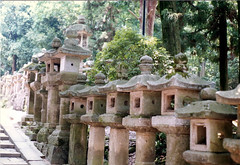 | 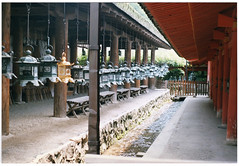 |
| Stone lanterns line the steps that approach the shrine | Bronze lanterns hang from the eaves of the shrine buildings |
Click on a photo to see a larger version. The large version will open in a new window; close that window to continue.
At that time we learned that the lanterns are all lit twice a year, and I wished that someday I'd have the chance to see that.
This time around, by pure coincidence, we were in the right area at the right time!
It was the festival of O-Bon, when the dead come back to visit. Families put out lights and incense to guide their ancestors home. People visit temples and shrines at night to enjoy the lights and also to pray, since at this time there is a special connection with the spirit world.
If you want to know more about the festival, this guy's site has some photos and info about O-Bon, including an extensive Q & A.
Kasuga Taisha with all its lanterns lit—it was just a magical sight. Charming, delightful, beautiful.
First we wandered the grounds for awhile (okay, we were lost), following winding paths lined with row upon row of stone lanterns.
Each little stone window was sealed with paper, and candles within cast a warm, flickering glow.
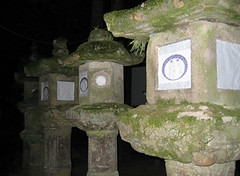 | 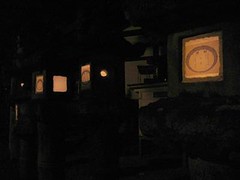 |
| Stone lanterns (used flash) | Same lanterns (one step closer; no flash) |
Click on a photo to see a larger version. The large version will open in a new window; close that window to continue.
I had a hard time photographing this—would have needed a tripod to do it properly—but use your imagination & maybe you can get the idea....
Then we joined the queue for the main building. Inside the gate, we came fairly quickly to the main worship hall...
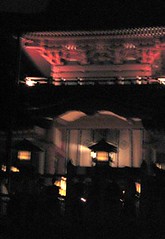 | 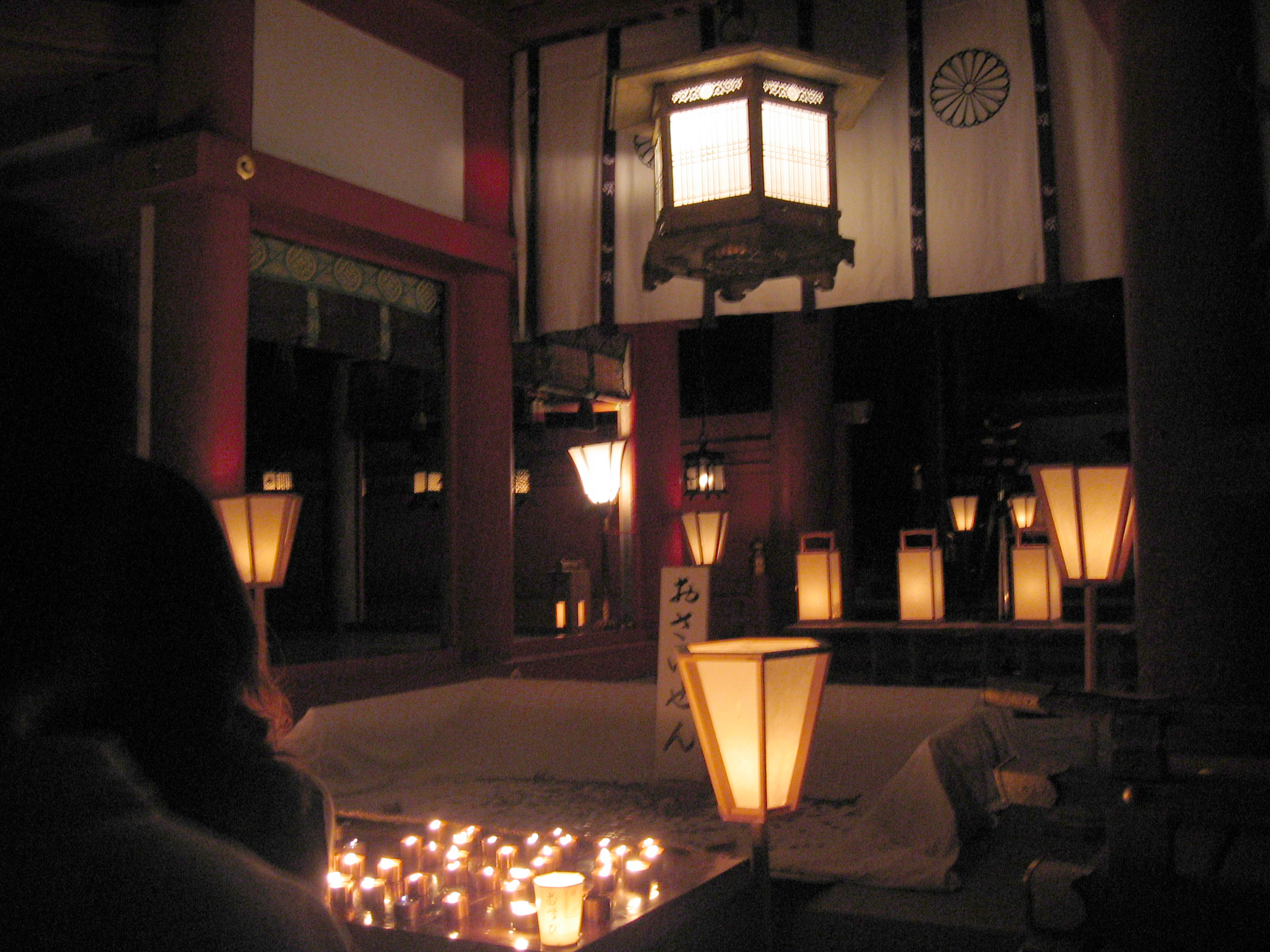 |
| Left: Main hall (honden) from a distance. Right: The vestibule (haiden) is as far as the public can approach. In the foreground are candles people have lit, and beyond that, a white cloth where people have thrown coins. Beyond that is the entrance to the inner sanctum, where only priests and miko may enter. | |
After that we proceeded through courtyards and walkways...up stairs and down...past row upon row upon row of bronze lanterns, lit from within with flickering candles.
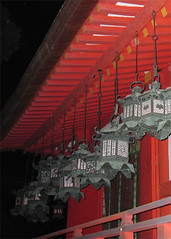 | 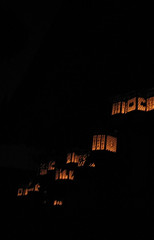 |
| Bronze lanterns hanging from the eaves (with flash) | Same lanterns (no flash) |
Click on a photo to see a larger version. The large version will open in a new window; close that window to continue.
Aside from the lanterns, and some tea light candles tucked into the corners of each stair step, it was pitch dark.
I stumbled along with the crowd, disoriented, just looking at the lights and taking pictures...so it all seems like a dream to me now.
All I remember clearly is the lanterns—everything else is a blur. Just like in these photos.
In another post I talked about how distressing the huge crowd was for Loopy.
But having acknowledged that, let me say that for me, even the unbelievably huge crowd didn't detract from the pleasure. Everyone was in a holiday spirit and so plainly enjoying themselves that it just added to the festival atmosphere.
Furthermore, we were guided at every turn by priests, miko, and boy scouts (!!) whose voices sang out in the dark with gentle admonitions like "please watch your footing here, it's a little slippery," and "please move along, other people are waiting."
Everyone was very orderly, moved along, etc., so for those of us without claustrophobia, it felt safe, easy, comfortable, and pleasant to be among them.
It was one of those times when you really appreciate that people in Japan obey the rules.
More than that, you appreciate how right they are that life is so much easier when everyone obeys the rules instead of having to be an individual, a rebel, do it their own way, etc. (That observation prompted a whole 'nother train of thought that I'll get to at some point, I hope).
The sense of collective delight was palpable—it wasn't just foreigners who were having a once-in-a-lifetime experience. I felt swept along in a sea of bobbing lights, disoriented but not afraid.
The sense of magic was also palpable...
In fact, it wasn't too hard to imagine that among all those bobbing lights, spirits might indeed be wending their way...
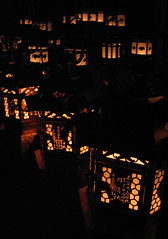
2 comments:
It was the hungry ghost festival here in Singapore recently. I wonder if there's a connection at all.
During this month, ghosts return from hell and you have to feed and entertain them to keep them happy. Folks throw large street operas and burn joss sticks, paper money, paper replicas of other material goods like BMWs, big houses, etc as gifts to their deceased relatives. Its very festive. We're now in the midst of the mid autumn festival, which is when all the kids go out with colorful lanterns on the night of the full moon, and mooncake is eaten.
Sounds like exactly the same thing, taking into account the difference in Chinese & Japanese ideas about the dead. Vengeful ghosts definitely exist, and I expect that hungry ghosts probably do too (at least, everyone I know over the age of 40 feeds their dead relatives daily, so I suppose there's a penalty for failing to do so), but I don't think they play the same role as they do (from what I understand) in China... there's more emphasis on "mizuko," babies who died without being named--they're definitely trouble--and otherwise, the ancestors are more often benevolent than otherwise.
From what I can tell, of course. I haven't made a study of it or anything.
They have the autumn moon festival in Japan too, but it's October 10 (ten-ten). I scanned in some photos of myself (age 16) participating in that...
ah mooncake, ah moon rabbit... I haven't missed Japan in so long (remember how crazy I was about Japan when you first met me??? insane...)
... but now I find I do, a little.
Hope you're having fun in S'pore!
Post a Comment